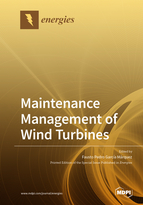Maintenance Management of Wind Turbines
A special issue of Energies (ISSN 1996-1073). This special issue belongs to the section "A3: Wind, Wave and Tidal Energy".
Deadline for manuscript submissions: closed (22 December 2019) | Viewed by 98464
Special Issue Editor
Interests: artificial intelligence; maintenance; management; advanced analytics; data science
Special Issues, Collections and Topics in MDPI journals
Special Issue Information
Dear Colleagues,
“Maintenance Management of Wind Turbines” considers the main concepts, the state-of-the-art, as well as advances and case studies on this topic. Maintenance is a critical variable in industry in order to reach competitiveness, being the most important, together with operations, in the wind energy industry. Therefore, the correct management of corrective, predictive and preventive politics in any wind turbine is required. This issue will consider original research works that show content complementary to other sub-disciplines, such as economics, finance, marketing, decision and risk analysis, engineering, etc., in the maintenance management of wind turbines.
The issue will also show real case studies. They will consider topics, such as failures detection and diagnosis, fault trees and subdisciplines (e.g., FMECA, FMEA, etc.). It is essential to link these topics with financial, schedule, resources, downtimes, etc., in order to increase productivity, profitability, maintainability, reliability, safety, availability, and reduce costs, downtimes, etc., in a wind turbine.
Advances in mathematics, models, computational techniques, dynamic analysis, etc., are employed in maintenance management.
It will also consider computational techniques, dynamic analysis, probabilistic methods, and mathematical optimization techniques that are expertly blended to support the analysis of multi-criteria decision-making problems with defined constraints and requirements.
Prof. Fausto Pedro García Márquez
Guest Editor
Manuscript Submission Information
Manuscripts should be submitted online at www.mdpi.com by registering and logging in to this website. Once you are registered, click here to go to the submission form. Manuscripts can be submitted until the deadline. All submissions that pass pre-check are peer-reviewed. Accepted papers will be published continuously in the journal (as soon as accepted) and will be listed together on the special issue website. Research articles, review articles as well as short communications are invited. For planned papers, a title and short abstract (about 100 words) can be sent to the Editorial Office for announcement on this website.
Submitted manuscripts should not have been published previously, nor be under consideration for publication elsewhere (except conference proceedings papers). All manuscripts are thoroughly refereed through a single-blind peer-review process. A guide for authors and other relevant information for submission of manuscripts is available on the Instructions for Authors page. Energies is an international peer-reviewed open access semimonthly journal published by MDPI.
Please visit the Instructions for Authors page before submitting a manuscript. The Article Processing Charge (APC) for publication in this open access journal is 2600 CHF (Swiss Francs). Submitted papers should be well formatted and use good English. Authors may use MDPI's English editing service prior to publication or during author revisions.
Keywords
- Maintenance
- Wind Turbines
- Diagnosis
- Prognosis
- Predictive Maintenance
- Preventive Maintenance
- Corrective Maintenance
- Downtime
- Strategy on Maintenance
- Maintenance Planning
- Resources Management
- Organization Management
- Finance
- Cost
- Profit
- Efficiency
- Reliability
- Availability
- Safety
- Maintainability
- Durability
- Alarms
- Condition Monitoring
- Maintenance Software






